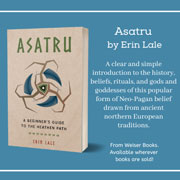Scattering Violets
An exploration of funerary traditions and innovations, care of the dead, and pagan perspectives on death
When the Spirit Goes: Death, the Afterlife, and the Translation of the Soul
Something I didn't expect when I started working at the pet funeral home was how much it would cause me to consider my beliefs about death and the afterlife. I knew I would usher the animal dead through their transformation and transition; I knew I would help individuals and families make memorial decisions while they grapple with fresh grief, and hopefully help them find comfort in that process. I saw myself as a purveyor of healing, not as a student. But, of course, I'm learning through my work as well.
In the selection room at my workplace, we meet with families to fill out paperwork and help them select urns and mementos. On one wall, we have an assortment of urn jewelry: necklaces and bracelets with hollows inside to fill with small amounts of cremated remains. In wearing these, our clients can keep a small piece of their beloved animal dead with them wherever they go, close to their hearts. This can be very intimate and healing during their grief journey. And grief is a journey, filled with many highs and lows as the grieving adjust to life without their near-constant companions.
We sell a wide variety of necklace urn styles, but one of my favorites that we’ve recently sold out of is an hourglass necklace urn, in which the cremated remains function the same as sand in regular hourglasses. It’s a tender memento mori: we all have limited time in this life. As the sands run out on our lives as we know them, we transition into new existences – the hourglass turns over and begins again. I've thought about buying one of these – or a teardrop, or tree of life, or a simple O-shaped necklace – to place the cremated remains of my first cat in, but for some reason, I don't feel comfortable with it. Dividing her remains feels like severing her from herself, and I’ve wondered why. What does it tell me about my beliefs regarding the connection between the spirit and the body once life is over?
When someone dies – whether a human, another animal, or a plant – a change occurs in the body-spirit complex. The body is no longer animated; the binding between it and the soul has been cut. Even so, I believe that the soul remains more loosely connected to the body, at least until the body disintegrates. It may roam, but there remains a wispy tether between the two. I think that the buried dead remain bound to the place where their bodies lie within the earth, whether it’s a cemetery, a forest, etc. As their bodies decay and break apart, they may become spirits of the land, a natural part of the landscape that forms their new bodies and new homes. Or they may move on and choose to reincarnate, either as a human or in some other form. We see this belief expressed in sagas and fairytales, in which the dead become elves and trolls, fairies and ghosts. There's the tale of Olaf Geirstad-Alf, who was inhumed in a barrow and worshiped as an elf who blessed his people even after death with fertile growing seasons. Eventually, he appeared in a dream to a man named Hrani and asked the latter to go into the barrow, chop off his head, and deliver artifacts to his foster brother's wife, who was in labor. When this was done, the baby who became Saint Olaf was born. This can be interpreted as a situation in which an elf-as-mighty-dead seeks reincarnation and is reborn through ritual dismemberment – destruction of the body – and gift-giving.
Cremation is essentially a speeding-up of the process of disintegration: everything but the bones is burned away, converted by fire from solid into gas, further broken down into carbon dioxide and water vapor, and released into the atmosphere. The bones are processed into a fine powder and placed in an urn, buried in the earth, or scattered. I wonder if this near-total destruction of the body is the point at which the soul leaves the body entirely, to join the masses in the Otherworlds of the dead, or the liminal places between this and the other, or to reincarnate. If so, the cremated remains are only a memento, and there's nothing taboo in placing the powdered bone into as many vessels as one wishes, no more terrible than giving away locks of hair.
But then I think of practices in magic that include bones, hair, nails, feathers, skins – spirit bottles, talismans, and the like. The magic works by recalling the spirits of the dead to whom these relics belonged, or by association with them. However physically separable they are, they can't be totally severed from the spirit that they originally embodied. Some threads remain intact, and spirits can be summoned through the use of them in magic. So perhaps my impulse to keep my cat's cremated remains together in one piece has something to do with potency – the more of her I hold together, the stronger the bond I believe I can maintain with her, through them.
To be honest, I don't think potency is really necessary, though. Just the small amount that fills a necklace urn should be enough. They're like any other relic – even a single bone holds power. As in "The Juniper Tree," a single bone can tell the story of the whole. So maybe my feelings will change.
Photo by Viktor Talashuk on Unsplash
Comments
-
Please login first in order for you to submit comments
















